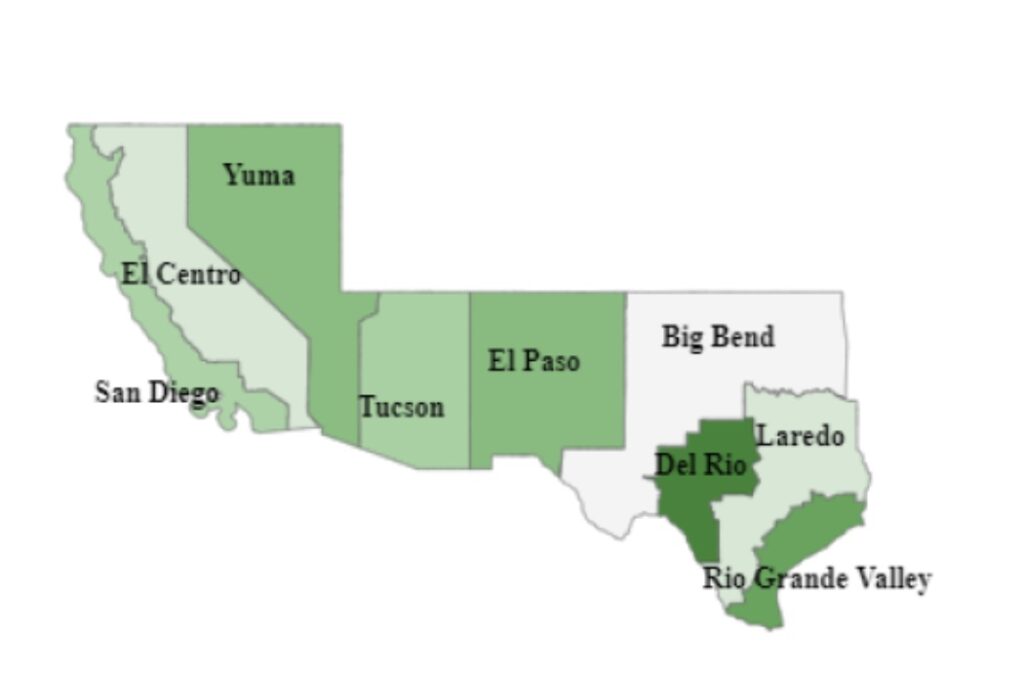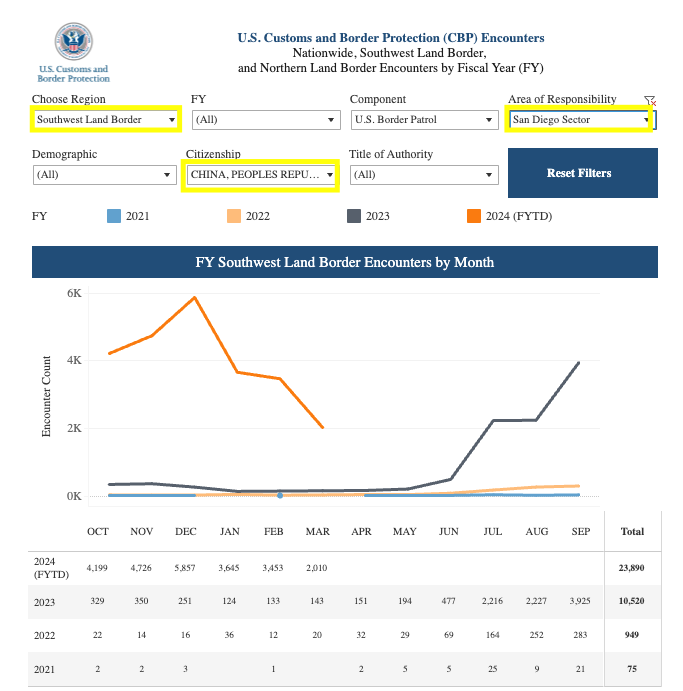(Daily Signal)—Chinese nationals are crossing America’s southern border at a rapid rate. On Wednesday alone, the U.S. Border Patrol encountered 206 Chinese nationals crossing into the San Diego sector, Fox News correspondent Bill Melugin reported.
But the illegal entry of Chinese nationals into America through the Border Patrol’s San Diego sector isn’t new. Chinese individuals long have worked with criminal cartels to get into the U.S., former Border Patrol Chief Rodney Scott says, but the numbers have shot up.
In January, U.S. Customs and Border Protection reported over 3,700 encounters with Chinese nationals on the southern border, nearly all in the San Diego sector.
But back up to January 2021, when Joe Biden became president, and CBP encountered only 17 Chinese nationals at the southern border. So what changed?
To find out why so many Chinese nationals are crossing the U.S.-Mexico border in the San Diego sector, The Daily Signal spoke to Scott as well as to Derek Maltz, a 28-year veteran of the U.S. Drug Enforcement Administration, and to Michael Cunningham, a research fellow in The Heritage Foundation’s Asian Studies Center. (Heritage founded The Daily Signal in 2014.)
They point to six main reasons.
1. San Diego Infrastructure
“It’s easy,” Scott said of why San Diego is a favorite crossing point for illegal immigrants from China.
Before serving as the 24th chief of the Border Patrol from January 2020 to August 2021, Scott was chief patrol agent for the San Diego sector from 2017 to 2019.
San Diego, population 1.4 million, long has been a popular illegal crossing point for illegal aliens because it’s easy to disappear on busy city streets, Scott explains.
“If you’re coming across [the border] in between the ports of entry through traditional smuggling, we used to talk about a vanishing point,” Scott said. “How fast can you get across the border and then blend into society? That’s one of the reasons you look for [urban] infrastructure.”
San Diego is even more popular now for illegal aliens, given the situation at the border, because “it’s a lower risk,” he said.
To cross into Texas from Mexico, “you’ve got to come across the river,” the former Border Patrol chief explained, adding that globally, smugglers and others seeking to enter the U.S. illegally have seen Texas Gov. Greg Abbott’s response to illegal immigration.
In an initiative called Operation Lone Star, the Republican governor placed Texas National Guard troops along sections of the border with Mexico and installed concertina and razor wire, creating a greater challenge for migrants seeking to cross the border illegally.
And in Arizona, the harsh realities of the desert are a turnoff for illegal aliens trying to cross into the U.S., Scott said. Although such conditions don’t prevent illegal crossings, he said, Arizona is “hot” and “desolate.”
-
Learn the TRUTH about Gold IRAs and how most precious metals companies play dirty.
Mexico’s border with California in the San Diego sector offers a safer, more comfortable crossing option, he said.
A migrant can go to Tijuana, Mexico, “be in a hotel drinking coffee, watching TV, get the ‘go,’ and in 15 minutes [he] can be in the United States,” Scott said.
In 20 more minutes, he said, that same migrant can be getting processed inside a Border Patrol station with “air conditioning, food, and water.”
When illegal aliens are released in San Diego, the city offers “this massive nongovernmental organizational network system that’s going to provide free bus tickets [and] shelter,” he said.
California also is a sanctuary state, meaning it doesn’t cooperate with federal authorities to enforce immigration law.
“From a marketing standpoint, it’s the easiest place to convince people to cross illegally,” Scott said of San Diego. “And then from a cartel perspective … that smuggling infrastructure has been well-established for years.”
2. Money Motivates Cartels
Chinese migrants are “lucrative” to the drug and smuggling cartels in Mexico, Scott told The Daily Signal.
“It’s pretty hard to get out of China,” the former Border Patrol chief said. “Nobody just goes to an airport and flies to the United States without specific permission from the government, so you have to be smuggled out of China and then into the United States.”
Chinese nationals buy “travel packages” from the cartels that are similar to commercial vacation travel packages, Scott said, and they pay based on what is included.
For example, he said, one package for Chinese nationals requires them to travel to Ecuador and then on to Mexico.
“And when they came into Mexico, they got legit legal travel documents so that they could fly on domestic airlines in Mexico. But for a lower fee, you didn’t get that.”
3. Because They Can
Established smuggling routes, urban or suburban infrastructure, and the cartels’ financial motivation long have driven illegal Chinese migration to the U.S. So again, why the spike now?
“The difference now,” Scott said, “is there’s no real response from the federal government of the United States to slow it down. There hasn’t been since 2021.”
Biden, a Democrat, was inaugurated Jan. 20, 2021, and quickly dismantled the border security policies of his defeated Republican predecessor, Donald Trump.
Now, with a Biden-Trump rematch looming in November, Scott speculated, migrants and smugglers are concerned that U.S. border security will return if Trump or another Republican wins. That may help explain the rapid rise in crossings in recent months.
Illegal crossings in the San Diego sector by Chinese nationals were relatively few at the beginning of the Biden administration.
CBP records only 75 encounters with Chinese migrants in the San Diego sector during fiscal year 2021, which ended that Sept. 30. The number climbed to 942 in fiscal 2022, then exploded to 10,520 in fiscal 2023.
So far in fiscal 2024, which ends in five months, CBP has encountered 23,890 Chinese nationals in the San Diego sector.
Cunningham, the research fellow in Heritage’s Asian Studies Center, told The Daily Signal that Chinese nationals “see all over the news that the border is wide open, that Biden is not protecting the border.”
So the question, he says, is “why wouldn’t they” attempt to cross into the U.S.?
4. ‘A Better Life’
“A lot of people are desperate to get out of China now,” Cunningham said.
During the COVID-19 pandemic, Chinese citizens endured about three years of lockdowns and restrictions that dwarfed those in the U.S. These “draconian lockdowns” led many Chinese to lose faith in their communist government, he said.
China’s older population lived through the Cultural Revolution from 1966 to 1976, if not previous repressive political campaigns, Cunningham said, before the regime implemented a strict “zero-COVID” policy.
“They saw zero-COVID as what it was—a political campaign. And they’re worried about China’s future,” he said of ordinary Chinese citizens.
“Beef Steak” – our most popular survival beef product – is on sale now.
Promo code “steak40” at checkout for 40% off!
Chinese leader Xi Jinping gained an opportunity to rule the nation indefinitely when the communist regime ended formal presidential terms in 2018.
China’s economy is struggling as young people try to find jobs, the nation’s real estate market is in trouble after the failure of two major property development companies this year, and its stock market saw a $7 trillion decline in just a few years.
“People for years have wanted to get their money out of China, and it’s very difficult because of capital controls,” Cunningham said. “Now more of them are just wanting to get out of China altogether for a better life.”
5. Chinese Influence on America
Through its Belt and Road Initiative, China plans to develop trade routes with other nations, expand infrastructure, and invest in foreign economic development initiatives.
With Chinese leaders’ end goal of expanding “their power and control dramatically,” Scott said, it is “not a hidden secret that they have long allowed and or even facilitated and helped getting people out of China into the U.S. through whatever means possible.”
The former Border Patrol chief pointed to reports that Chinese nationals are “systematically coming into the United States and buying property, buying foreign property, buying property near military bases,” as evidence that they are crossing the border intentionally.
China owns 384,000 acres in the U.S., about 1% of foreign-held acres, according to a Department of Agriculture report in 2021, the latest data available.
Although illegal immigrants could achieve some cultural and economic influence on America, Cunningham said, it’s unlikely that significant numbers of Chinese nationals cross the southern border with the intent of spying on the U.S.
Legal ways to enter the U.S., he said, provide greater opportunity for Chinese spies to access sensitive U.S. data than an illegal alien could get at.
“The idea that China is desperate to get their spies in the U.S. and so they’re sending them across the border illegally where they’re going to have no identity, they’re not going to be capable of getting the high-access jobs that they want their spies to get—it’s just not reasonable,” Cunningham said.
But, he added, it’s reasonable to believe that Chinese spies are infiltrated within criminal cartels and are “keeping tabs on some of the Chinese who are coming to America.”
6. Marijuana Farms
The Chinese are heavily involved in the domestic growth of marijuana in America, both legal and illegal, federal officials say.
In February, 50 members of the House and Senate sent a letter to Attorney General Merrick Garland expressing concern about and asking for answers to “reports from across the country regarding Chinese nationals and organized crime cultivating marijuana on United States farmland.”
“There’s a new term that’s been used a lot lately in local law enforcement—especially [in] Northern California [and] the inland parts of California—called narco slavery,” Scott told The Daily Signal. “And they’re seeing more and more Chinese that are being brought across and they’re being forced to work these domestic marijuana grows; they’re being forced to shovel money around the United States to pay back the smuggling fee that they couldn’t afford up front.”
Chinese-run marijuana grow operations “are all over the country,” Maltz, the former DEA official, told The Daily Signal.
This isn’t a coincidence, he said.
“Beef Steak” – our most popular survival beef product – is on sale now.
Promo code “steak40” at checkout for 40% off!
“The marijuana today has high content of THC, much higher than we’ve ever seen,” Maltz said.
THC, formally known as tetrahydrocannabinol, is a psychoactive compound found in cannabinoids. Large amounts increase the effects of marijuana on the user.
“Marijuana use directly affects brain function—specifically the parts of the brain responsible for memory, learning, attention, decision-making, coordination, emotions, and reaction time,” according to the Centers for Disease Control and Prevention.
Cannabis products have been legalized for medical use in 38 states and legalized for nonmedical use in 24 states.
The increased levels of THC in marijuana are “causing issues with the brain more than we’ve ever seen,” said Maltz, who also was in charge of the Justice Department’s Special Operations Division for nearly 10 years.
“Very smart Chinese Communist Party leaders understand this is another way we could take advantage of America’s addiction to marijuana, and dumb Americans will never figure it out,” he said.







